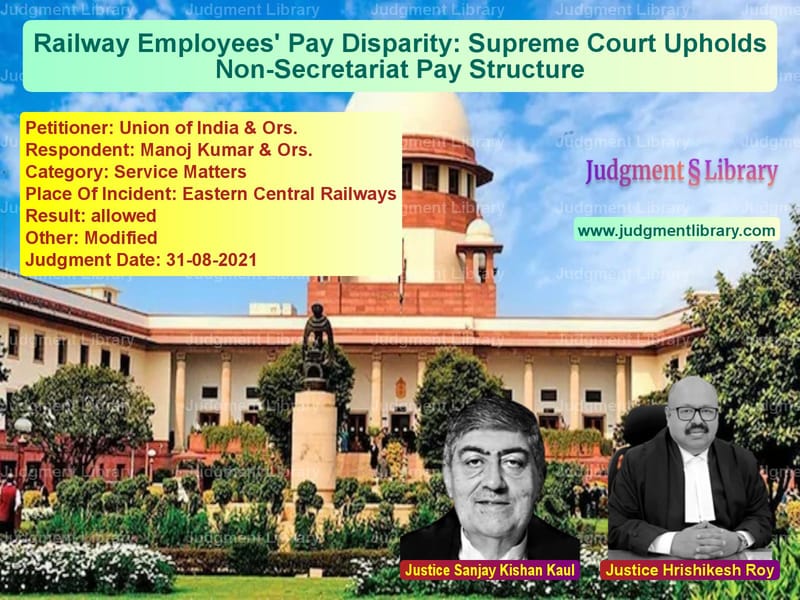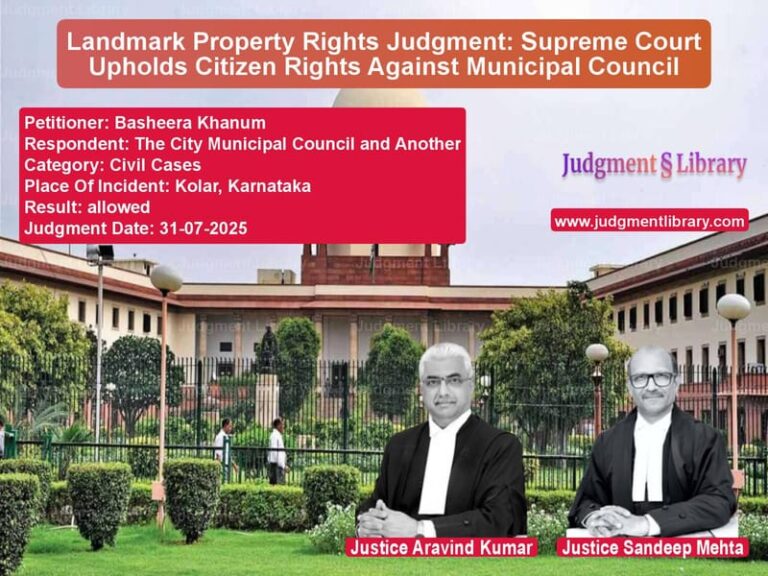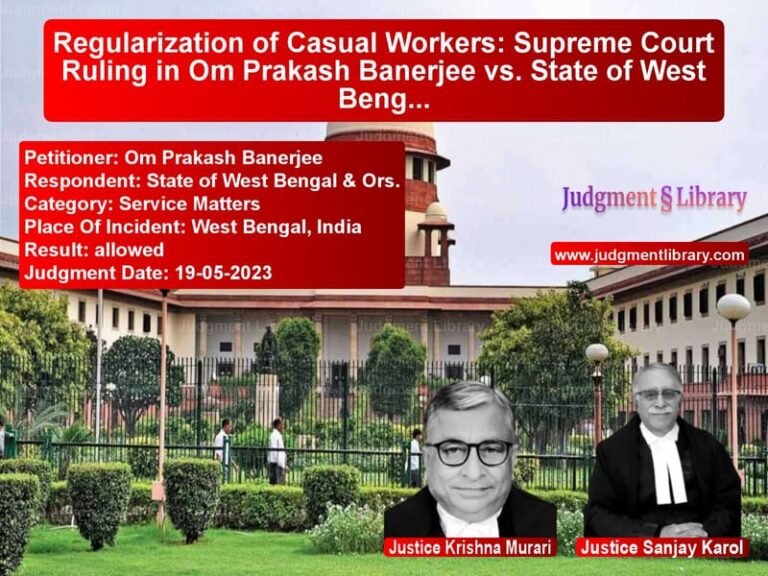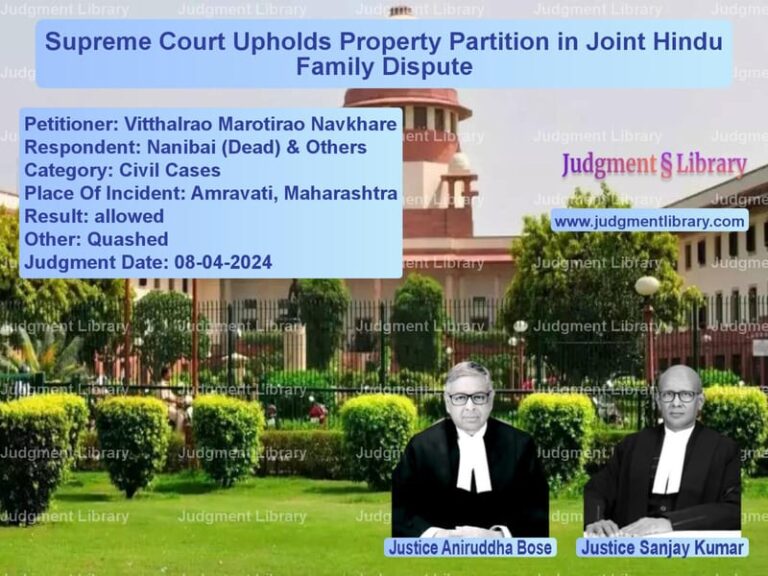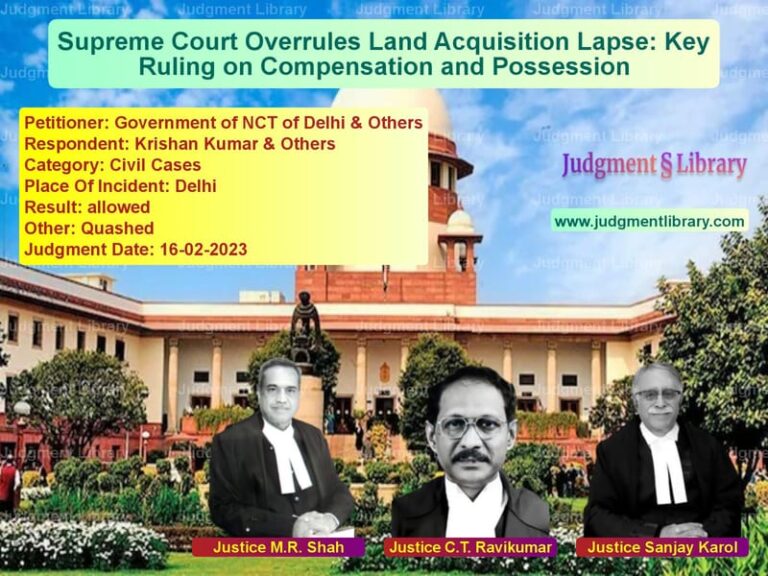Railway Employees’ Pay Disparity: Supreme Court Upholds Non-Secretariat Pay Structure
The case of Union of India & Ors. vs. Manoj Kumar & Ors. revolved around the issue of pay disparity between Private Secretaries (Grade-II) in the Eastern Central Railways and their counterparts in the Central Secretariat Stenographers Service (CSSS), Railway Board Secretariat Service (RBSSS), and Central Administrative Tribunal (CAT). The Supreme Court was tasked with deciding whether these employees in the Zonal Railways should receive the same pay scale as those working in Secretariat services.
Case Background
The Indian Railways is one of the largest employers in the country, comprising six production units and eighteen zones, each having three to six divisions. The Sixth Central Pay Commission (6th CPC) examined the demands for higher pay scales and allowances across various departments, including the Ministry of Railways.
The respondents, who were Private Secretaries (Grade-II) employed in Eastern Central Railways, argued that they were entitled to parity in pay with their counterparts in CSSS, RBSSS, and CAT. They based their claims on the 6th CPC report, which referred to common category posts and the need for parity between Secretariat and Field offices.
The Union of India, however, opposed this demand, arguing that there was a clear distinction between Secretariat and non-Secretariat offices. The government maintained that field offices, including Zonal Railways, performed different functions and did not qualify for the same pay structure.
Arguments by the Petitioners (Union of India & Ors.)
- The 6th CPC report clearly differentiated between Secretariat and non-Secretariat organizations.
- “Private Secretaries in Zonal Railways cannot claim parity with their counterparts in Secretariat offices, as their work nature and career progression are different,” argued the government.
- Pay commissions have historically treated non-Secretariat organizations differently from Secretariat services.
- The Central Administrative Tribunal (CAT), in similar cases, had ruled that there was no basis for granting equal pay to non-Secretariat employees.
Arguments by the Respondents (Manoj Kumar & Ors.)
- The respondents argued that their recruitment process and job responsibilities were similar to those of Private Secretaries in Secretariat services.
- “The 6th CPC report acknowledged the need for parity between field offices and Secretariat offices, and therefore, the pay scale should be equal,” contended the respondents.
- They cited previous cases where other non-Secretariat employees were granted higher pay scales.
- The disparity in pay violated the principle of ‘equal pay for equal work.’
Supreme Court’s Observations
The Supreme Court examined three main issues:
1. Did the 6th CPC mandate absolute pay parity between Secretariat and non-Secretariat employees?
- The Court observed that while the 6th CPC recommended parity in lower grades, it did not extend the same to senior posts.
- “The Pay Commission clearly distinguished between Secretariat and non-Secretariat organizations, particularly beyond the Assistant level,” the Court noted.
2. Should Private Secretaries in Zonal Railways receive the same pay scale as those in CSSS and RBSSS?
- The Court found that the respondents did not belong to Secretariat services and were governed by different recruitment rules.
- “There is no historical parity between Private Secretaries in Zonal Railways and those in CSSS, RBSSS, or CAT,” the judgment stated.
3. Did the High Court and CAT err in granting higher pay scales?
- The Supreme Court ruled that the CAT and the High Court had misinterpreted the Pay Commission’s recommendations.
- “Once the Pay Commission has made a clear distinction, courts should not interfere with its findings,” the Court emphasized.
Supreme Court’s Judgment
The Supreme Court ruled:
- “The judgment of the High Court granting pay parity to the respondents is set aside.”
- “The pay structure for Private Secretaries in Zonal Railways, as determined by the government, is upheld.”
- “Non-Secretariat organizations cannot claim the same pay scale as Secretariat offices beyond the level of Assistant.”
Conclusion
The Supreme Court’s ruling clarifies that pay parity between Secretariat and non-Secretariat offices cannot be absolute. While lower-grade employees may receive similar treatment, senior posts in field offices are subject to different rules. This judgment ensures that pay commission recommendations are not arbitrarily modified by courts, maintaining structural consistency in government pay scales.
Petitioner Name: Union of India & Ors..Respondent Name: Manoj Kumar & Ors..Judgment By: Justice Sanjay Kishan Kaul, Justice Hrishikesh Roy.Place Of Incident: Eastern Central Railways.Judgment Date: 31-08-2021.
Don’t miss out on the full details! Download the complete judgment in PDF format below and gain valuable insights instantly!
Download Judgment: union-of-india-&-ors-vs-manoj-kumar-&-ors.-supreme-court-of-india-judgment-dated-31-08-2021.pdf
Directly Download Judgment: Directly download this Judgment
See all petitions in Employment Disputes
See all petitions in Public Sector Employees
See all petitions in Recruitment Policies
See all petitions in Judgment by Sanjay Kishan Kaul
See all petitions in Judgment by Hrishikesh Roy
See all petitions in allowed
See all petitions in Modified
See all petitions in supreme court of India judgments August 2021
See all petitions in 2021 judgments
See all posts in Service Matters Category
See all allowed petitions in Service Matters Category
See all Dismissed petitions in Service Matters Category
See all partially allowed petitions in Service Matters Category

